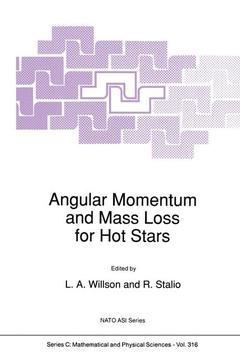Angular Momentum and Mass Loss for Hot Stars, Softcover reprint of the original 1st ed. 1990 Nato Science Series C: Series, Vol. 316
Langue : Anglais
Coordonnateurs : Willson L.A., Stalio R.

Fundamental unsolved problems of stellar astrophysics include the effects of angular momentum on stellar structure and evolution, the nature and efficiency of the processes by which angular momentum is redistributed within and lost from stars, and the role that stellar rotation plays in enhancing or driving stellar mass loss. There appears to be a qualitative change in the nature and efficiency of these mechanisms near spectral type FO: hotter (more massive) stars typically retain more angular momentum at least until they reach the main sequence, while cooler stars typically spin down quickly. For the hotter stars, recent work suggests a strong link between the type of pulsation behavior, the mass loss rates, and the rotation velocity. If the same mechanisms are able to drive mass loss from the main sequence A stars, as has recently been proposed, then the current interpretations of a number of observations will be drastically affected: e. g. the ages of clusters may be incorrect by up to a factor of two, and the surface abundances of isotopes of He, Li and Be may no longer give constraints on cosmological nucleosynthesis. There are also effects on the evolution of the abundances of elements in the interstellar medium and on the general evolution of populations of stars. Thus the questions of the mechanisms of angular momentum and mass loss of stars more massive than the sun is important not only for stellar studies but for the foundations of much of modern astrophysics.
Why a Meeting on Angular Momentum and Mass Loss for Hot Stars?.- Angular Momentum and Mass Loss and Stellar Evolution.- The Effects of Rotation on Stellar Structure and Evolution.- New Evolutionary Aspects of Mass Loss and Angular Momentum.- Mass Loss During the Evolution of Massive Stars.- Pre-Main Sequence Stages.- Angular Momentum Loss in Pre-Main Sequence Objects and the Initial Angular Momentum of Stars.- The Herbig Ae and Be Stars: Mass and Angular Momentum Losses.- Eccentric Spiral Modes in Disks Associated with Young Stellar Objects.- Evidence that Wolf-Rayet Stars are Pre-Main Sequence Objects.- A and F Stars near the Main Sequence.- Rotation, Pulsation and Atmospheric Phenomena in A-Type Stars.- Pulsation Studies of a 1.8 M? Delta Scuti Model.- Post-Main Sequence Evolution of Binary Am Stars.- A Statistical Study of Main Sequence A and F Stars: Testing the Main Sequence Mass Loss Hypothesis.- O, B and Be Stars.- Basic Magnetic Rotator Theory with Application to the Angular Momentum Driven Winds of B[e] and Wolf Rayet Stars.- The Connection between Rotation and the Winds of Be Stars.- UV Glimpse of OB Stars.- Nonspherical Radiation Driven Wind Models Applied to Be Stars.- A Simple Criterion to Identify Rapidly Rotating Stars Viewed at Small to Intermediate Inclination Angles.- Intensive Photometric Campaign on Be Stars: Behaviour of Short-Term Periodic Variations and its Relationship to Pulsation and Mass Loss.- Constraints on the Thickness of Be Star Disks Derived from Combined IR Excess and Optical Polarimetry Data.- On the Correlation between Pulsation Amplitude and Shell Activity in the Be star ? Eridani.- B[e] Supergiants: Continuum Polarization by Electron Scattering in Rotationally Distorted, Radiation Driven Stellar Winds.- Rotational Evolution ofHot Stars due to Mass Loss and Magnetic Fields.- New Facts About the Variability of 45 ? Persei.- Long-Term Study of Stellar-Wind Variability of O Stars.- HeII ?1640 as a Diagnostic for Assessing the Extent of Rapid Rotation in Be Stars.- Some Examples of the Role of Stellar Rotation in Hot Star Winds.- HD 193077 -- A Fast Rotating Wolf-Rayet Star.- How Effective is Rotation in Enhancing the Rate of Mass Loss in Early Type Stars?.- Rotation and Pulsation-Mode-Selection in B-Type Stars.- The Angular Momentum-Loss and the Differential Rotation in B and Be Stars.- Very Luminous and Very Massive Stars.- The Role of Axial Symmetry in the Upper Part of the HRD: B[e] Supergiants and LBVs.- Effects of Mass Loss on Late Stages of Massive Star Evolution.- V444 Cygni and CQ Cephei, Key Wolf-Rayet Binary Stars.- Rotation of Hot Stars After They Cool Off.- Winds, Mass Loss and Rotation in Central Stars of Planetary Nebulae.- White Dwarf Mass Loss, Rotation, Individual Masses and the Identification of the White Dwarf Remnants of Upper Main Sequence Stars.- Evolved Stars as Probes of Main Sequence Angular Momentum and Mass Loss.- The Bizarre Kinematics of Planetary Nebula NGC 7009, and Some Thoughts on the Transfer of Stellar Angular Momentum to Planetary Nebulae.- Chromospheric H? Activity in ? ORI.- Stellar Winds in A-Type Supergiants.- Special Section: A Debate Concerning the Nature of Wolf-Rayet Stars.- The Evidence that Wolf-Rayet Stars are in a Late Stage of Evolution.- Why Wolf-Rayet Stars Should Not Be Considered To Be Evolved Cores of Massive Stars.- Author index.- Keyword index.- Astronomical index.
Date de parution : 09-2011
Ouvrage de 365 p.
15.5x23.5 cm
Thème d’Angular Momentum and Mass Loss for Hot Stars :
Mots-clés :
Population; Variation; astrophysics; interstellar matter; planet; star; stellar; stellar evolution; stellar structure; sun
© 2024 LAVOISIER S.A.S.



